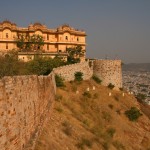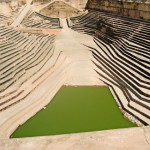
Rajasthan is home to some of the most stately forts in the country. Either standalone or in combination with another fortress, the forts were primarily used for the defence of capital cities. The forts of Nahargarh, Amer and Jaigarh once formed a fortified defence ring for the city of Jaipur. Maharaja Sawai Jai Singh II got this fort constructed in 1734 and it was initially called Sudarshangarh Fort but was later christened Nahargarh which literally means ‘abode of tigers’.
 According to the popular belief, “Nahargarh” comes from Nahar Singh Bhomia, a Rathore prince whose spirit haunted the place and obstructed the construction of the fort. Prince’s spirit was pacified by building a temple in his memory within the fort and the fort was given the name “Nahargarh”.
According to the popular belief, “Nahargarh” comes from Nahar Singh Bhomia, a Rathore prince whose spirit haunted the place and obstructed the construction of the fort. Prince’s spirit was pacified by building a temple in his memory within the fort and the fort was given the name “Nahargarh”.
The fort is nestled in the Aravallis Range and offers a breathtaking view of the surroundings. A special feature of the fort is its extended wall which connects it to the Jaigarh Fort. The fort was originally built as a place of retreat.
In 1868, Sawai Ram Singh got the Nahargarh Fort renovated and extended. Later, between 1883 to 92, Sawai Madho Singh got a range of palaces built which cost around three and a half lakh rupees at that time.
Page Contents
Architectural Layout of The Fort
 The fort’s architectural style is largely Indo-European. There are several structures inside the fort. Towards the left of the entrance called “Tadigate”, is a temple which is dedicated to the presiding deity of the rulers of Jaipur. Another temple inside the fort is dedicated to the Rathore prince Nahar Singh Bhomia. Madhavendra Bhawan constructed by Sawai Madho Singh is another attraction of the fort. The “Bhawan” is a two-storey building which housed suites for the king and his twelve queens. The rooms, adorned with delicate frescoes, are connected by corridors. It comprises nine similarly built apartments with each one having a lobby, bedrooms, toilets, kitchen and store. Diwan-I-Aam and an open air enclosure where the king conducted meetings with common men to discuss their issues are other structures inside the fort.
The fort’s architectural style is largely Indo-European. There are several structures inside the fort. Towards the left of the entrance called “Tadigate”, is a temple which is dedicated to the presiding deity of the rulers of Jaipur. Another temple inside the fort is dedicated to the Rathore prince Nahar Singh Bhomia. Madhavendra Bhawan constructed by Sawai Madho Singh is another attraction of the fort. The “Bhawan” is a two-storey building which housed suites for the king and his twelve queens. The rooms, adorned with delicate frescoes, are connected by corridors. It comprises nine similarly built apartments with each one having a lobby, bedrooms, toilets, kitchen and store. Diwan-I-Aam and an open air enclosure where the king conducted meetings with common men to discuss their issues are other structures inside the fort.
Historic Importance
During the course of history, Nahargarh Fort was never attacked but it has been witness to some major historical events. The treaties with the Maratha forces which attacked Jaipur in the 18th century were made here. The fort was also the shelter for many Europeans present in the region, including the British Resident’s wife, during the Sepoy Mutiny of 1857.
Nearby Tourist Attractions
Jantar Mantar, one of the five major astronomical observatories in Western India is merely 2.7 km away from the fort. Other major attractions in the vicinity include City Palace, Hawa Mahal, Jalmahal, Jaigarh Fort and Amer Fort.

Facebook comments: ManaHotels